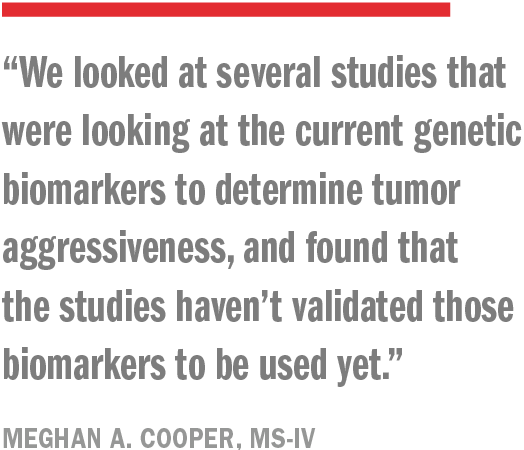Article
Biomarkers yet to fully justify claimed clinical utility
Biomarker models to predict disease progression in prostate cancer have a promising future, but at present, they have not fully justified their claimed clinical utilities, according to the authors of an independent review and analysis of the literature.
Orlando, FL-Biomarker models to predict disease progression in prostate cancer have a promising future, but at present, they have not fully justified their claimed clinical utilities, according to the authors of an independent review and analysis of the literature.
COMMENTARY: New PCa technologies bring hope, caution
The capability of each of the three assays studied-OncoType Dx, Decipher, and Prolaris-to predict high-risk disease was uncertain based on analysis of eight studies, said Meghan A. Cooper, MS-IV, Lake Erie College of Osteopathic Medicine, Bradenton, FL, at the Genitourinary Cancers Symposium in Orlando, FL. Cooper’s work was directed by Julio Pow-Sang, MD, of the H. Lee Moffitt Cancer Center and Research Institute, Tampa FL.
“The heterogeneity of prostate cancer makes accurate prediction of disease progression critical, as current parameters for treatment of localized prostate cancer are still very crude,” the authors noted.
“We looked at several studies that were looking at the current genetic biomarkers (Prolaris, Decipher, OncoType DX) to determine tumor aggressiveness, and found that the studies haven’t validated those biomarkers to be used yet,” said Cooper.
ALSO SEE: Test significantly impacts prostate Ca Tx recommendations
The literature was surveyed for relevant articles relating to the assays’ use in prostate cancer specifically. After screening 32 articles, eight were chosen for review and analysis based on a relatively large sample size for reliable statistical analysis, original and validation studies that used datasets from independent patient cohorts, and appropriate statistical evaluations. Prolaris was evaluated in four studies, Decipher in three, and Oncotype DX in two.
The assays’ predictive capabilities were quantified using hazard ratio (HR), odds ratio (OR), area under the curve, or precision and reproducibility.
NEXT: Predictive capabilities revealed
Have you read:
Post-RP radiation therapy on decline in U.S.
How ‘chemoimmunotherapy’ may help destroy advanced PCa
Statins may improve prostate cancer outcomes
Predictive capabilities revealed
The four studies of the cell cycle progression score (Prolaris) revealed multivariate HRs of 1.47 (582 patients) for biochemical recurrence and metastatic disease for every one-unit increase in gene expression, 1.77 (366 patients) for biochemical recurrence, 2.55 (337 patients) for biochemical recurrence, and 2.11 (141 patients) for biochemical failure and distant metastasis after radical prostatectomy.

The three studies of Decipher showed HRs of 2.88 (medium risk) and 8.23 (high risk) for biochemical failure, and 2.35 (medium risk) and 14.28 (high risk) for distant metastases. The genomic classifier achieved an area under the curve of 0.75 (95% CI: 0.67-0.83) as a predictor of early clinical metastasis, 0.75 (95% CI: 0.67-0.84) for biochemical failure in another study, and 0.78 (95% CI: 0.54-0.91) for distant metastases in a third study.
The Genomic Prostate Score (Oncotype DX) that incorporates 17 genes into an algorithm predicted high-grade and/or high-stage disease with a multivariate OR of 2.1 in one study. Analytical precision and reproducibility were 1.86 (95% CI: 1.6-2.2) and 2.11 (95% CI: 1.83-2.50) in another study of OncoType DX in which 10 prostate cancer RNA samples were assessed.
Despite the predictive capabilities discovered in these studies, “Most of the studies were retrospective in nature, had smaller sample sizes, and didn’t show big differences between the clinical variables we used,” Cooper said. “We see a future for these tests, but we see the need for prospective studies and randomized clinical trials.”
More on Prostate Cancer
Allograft wrap helps restore post-RP continence, potency
Product Preview: Liquid Bx accurately identifies high-grade PCa
State of Urology: Our experts' top picks for AUA 2015
Subscribe to Urology Times to get monthly news from the leading news source for urologists.
















